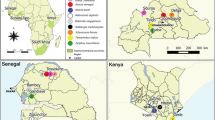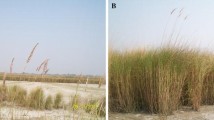Abstract
In the eastern United States, there is interest among forest landowners in American ginseng husbandry, and particularly in cultivating this plant on forestlands using a wild-simulated forest farming approach. This study documented the flora and soil conditions associated with wild and wild-simulated ginseng populations throughout Pennsylvania (PA) to develop floristic “indicators” that can be used to identify supportive growing sites on forestlands. A total of 243 plant species were documented associates of ginseng across PA: 32 over-story trees, 37 shrubs and understory trees, 15 vines, 143 herbs, and 16 ferns. Statistical analysis revealed a largely shared floristic assemblage throughout the state although some associates did differ according to region and physiographic province. Previous studies have suggested that a soil calcium content, especially soils having at least 3,360 kg ha−1 (3,000 lbs ac), appear to be particularly conducive to wild and wild-simulated ginseng occurrence and/or vigor, and indicator species analysis in this study revealed that three of the top plant associates that can be used for determining sites that meet this calcium threshold in PA are white ash, Jack-in-the-pulpit, and rattlesnake fern. These results suggest that successful adoption of wild-simulated ginseng forest farming is likely to be improved in forested areas where these species are found collectively as a dominant component of local plant assemblages.



Similar content being viewed by others
References
Anderson MP (1996) American ginseng (Panax quinquefolium L.) in Southwestern Wisconsin: Patterns of Demography and Habitat Associations. MS Thesis. University of Wisconsin, Madison
Anderson RC, Fralish JS, Armstrong JE, Benjamin PK (1984) Biology of ginseng (Panax quinquefolium L.) in Illinois. Illinois Department of Conservation, Division of Forest Resources and Natural Heritage. Springfield, IL
Anderson RC, Fralish JS, Armstrong JE, Benjamin PK (1993) The ecology and biology of Panax quinquefolium L. (Araliaceae) in Illinois. Am Midl Nat 129(2):357–372
Beck DE (1990) Yellow-poplar (Liriodendron tulipifera) in Burns RM and Honkala BH (tech. cords). Silvics of North America: 2. Hardwoods. Agriculture Handbook 654. U.S. Department of Agriculture, Forest Service, Washington, DC
Bergen FD (1894) Popular American Plant Names III. Araliaceae. J Am Folklore 7(15)
Beyfuss B (1999) The practical guide to growing ginseng. Cornell Cooperative Extension of Greene County, Cairo
Beyfuss B (2000) Soil nutrient characteristics of wild ginseng populations in New York, New Jersey, Maine, and Tennessee. In: Beyfuss RL (ed) Proceedings of the “American Ginseng Production in the 21st Century” Conference, September 8–10, 2000. Cornell Cooperative Extension of Greene County, Cairo, pp 105–114
Bierzychudek P (1982a) Life histories and demography of shade-tolerant temperate forest herbs: a review. New Phytol 90:757–776
Bierzychudek P (1982b) The demography of jack-in-the-pulpit, a forest perennial that changes sex. Ecol Monogr 52(4):335–351
Burkhart EP (2011) “Conservation through cultivation:” economic, socio-political and ecological considerations regarding the adoption of ginseng forest farming in Pennsylvania. Ph.D. Dissertation, Pennsylvania State University, University Park
Burkhart EP, Jacobson MG (2009) Transitioning from Wild collection to forest cultivation of indigenous medicinal forest plants in eastern North America is constrained by lack of profitability. Agrofor Syst 76(2):437–453
Burkhart EP, Jacobson MG, Finley J (2012) Stakeholder perspective and experience with wild American ginseng (Panax quinquefolius L.) conservation efforts in Pennsylvania, U.S.A.: limitations to a CITES driven, top–down regulatory approach. Biodivers Conserv 21(14):3657–3679
Carlson AW (1986) Ginseng: America’s botanical drug connection to the orient. Econ Bot 40(2):233–249
Carpenter SG (1980) Population dynamics, life history, and management recommendations for American ginseng (Panax quinquefolius L.) in Wisconsin. MS Thesis. University of Wisconsin. Madison, WI
Causton DR (1987) An introduction to vegetation analysis: principles, practice, and interpretation. Uniwn Hyman, Boston, MA
Court WE (2000) Ginseng: the genus Panax. Harwood Academic Publishers, The Netherlands
Curtis JT, McIntosh RP (1951) An upland forest continuum in the prairie-forest border region of Wisconsin. Ecology 32:476–496
Dufrêne M, Legendre P (1997) Species assemblages and indicator species: the need for a flexible asymmetrical approach. Ecol Monogr 67:345–366
Eckert D and Sims JT (1995) Recommended Soil pH and Lime Requirement Tests, In: Sims JT and Wolf A (eds) Recommended soil testing procedures for the Northeastern United States. Northeast Regional Bulletin #493. Agricultural Experiment Station, University of Delaware, Newark, DE, pp 11–16
Evans BL (1985) Ginseng: root of Chinese–Canadian relations. Can Hist Rev LXVI 1:1–26
Farrington SJ (2006) An ecological study of American ginseng (Panax quinquefolius L.) in the Missouri Ozark highlands: effects of herbivory and harvest, ecological characterization and wild simulated cultivation. MS Thesis. University of Missouri, Columbia
Fountain MS (1982) Site factors associated with natural populations of ginseng in Arkansas. Castanea 47:261–265
Fountain MS (1986) Vegetation associated with natural populations of ginseng (Panax quinquefolium) in Arkansas. Castanea 51(1):42–48
FWS—United States Fish and Wildlife Service (2012) American ginseng harvest data reported by 19 states to the USFWS. Data obtained from the USFWS–Division of Scientific Authority by Request (Jan)
Gee GW and Bauder JW (1986) Particle size analysis. In: Klute A (ed) Methods of soil analysis. Part 1. Physical and mineralogical methods. Agronomy Monograph #9. 2nd edn. American Society of Agronomy, Madison, WI, pp 383–411
Gilliam FS, Roberts MR (eds) (2003) The herbaceous layer in forests of eastern North America. Oxford University Press, New York
Gleason HA, Cronquist A (1991) Manual of vascular plants of northeastern United States and adjacent Canada, 2nd edn. The New York Botanical Garden, Bronx
Godman RM, Yawney HW, Tubbs CH (1990) Sugar Maple (Acer saccharum) in Burns RM and Honkala BH (tech. cords). Silvics of North America: 2. Hardwoods. Agriculture Handbook 654. U.S. Department of Agriculture, Forest Service, Washington, DC
Hill DB and Buck LE (2000) Forest farming practices. In: Garrett HE. Rietveld WJ and Fisher RF (eds) North American agroforestry: an integrated science and practice. American Society of Agronomy, Madison, WI, pp 283–320
Horsley SB, Bailey SW, Ristau TE, Long RP, Hallett RA (2008) Linking environmental gradients, species composition, and vegetation indicators of sugar maple health in the northeastern United States. Can J For Res 38:1761–1774
Hu SY (1976) The Genus Panax (Ginseng) in Chinese medicine. Econ Bot 30:11–28
Jones RT and Wolf J (2001) Report of 1999 Wild Ginseng Monitoring Program in Kentucky. Empire State Ginseng Growers Association (ESGGA) News 3 (1). April
Kent M, Coker P (1992) Vegetation description and analysis: a practical approach. Wiley, New York
Konsler TR, Shelton JE (1990) Lime and phosphorus effects on American ginseng: I. Growth, soil fertility, and root tissue nutrient status response. J Am Hortic Soc 115(4):570–574
Konsler TR, Zito SW, Shelton JE, Staba EJ (1990) Lime and phosphorus effects on American ginseng: II. Root and leaf ginsenoside content and their relationship. J Am Hortic Soc 115(4):575–580
Lim W, Mudge KW, Vermeylen F (2005) Effects of population, age, and cultivation methods on ginsenoside content of Wild American ginseng (Panax quinquefolium). J Agric Food Chem 53:8498–8505
Long RP, Horsley SB, Hallett RA, Bailey SW (2009) Sugar maple growth in relation to nutrition and stress in the northeastern United States. Ecol Appl 19(6):1454–1466
McCune B, Grace JB (2002) Analysis of ecological communities. MJM Software Design, Gleneden Beach
McGonigle TP, Hovius JP, Peterson RL (1999) Arbuscular mycorrhizae of American ginseng (Panax quinquefolius) in cultivated field plots: plant age affects the development of a colonization lag phase. Can J Bot 77:1028–1034
McGraw JB, Sanders SM, Van der Voort M (2003) Distribution and abundance of Hydrastis canadensis L. (Ranunculaceae) and Panax quinquefolius L. (Araliaceae) in the central Appalachian region. J Torrey Bot Soc 130(2):62–69
McWilliams WH, Cassell SP, Alerich CL, Butler BJ, Hoppus ML, Horsley SB, Lister AJ, Lister TW, Morin RS, Perry CH, Westfall JA, Wharton EH, Woodall CW (2007) Pennsylvania’s Forest, 2004. Resource Bull. NRS-20. Newtown Square, PA: U.S. Department of Agriculture, Forest Service, Northern Research Station
Nadeau I, Olivier A (2003) Revue de la biologie et de la production du ginseng à cinq folioles (Panax quniquefolius L.) en milieu forestier au Canada. Can J Plant Sci 83:877–891
Nadeau I, Olivier A, Simard RR, Coulombe J, Yelle S (1999) Growing American ginseng in maple forests as an alternative landuse system in Quebec, Canada. Agrofor Syst 44:345–353
Nadeau I, Simard RR, Olivier A (2003) The impact of lime and organic fertilization on the growth of wild-simulated American ginseng. Can J Plant Sci 83:603–609
OMAFRA—Ontario Ministry of Agriculture and Food (2005) Production recommendations for ginseng. Publication 610. Ministry of Agriculture and Food, Toronto, Canada
Persons WS, Davis JM (2005) Growing and marketing ginseng, goldenseal and other woodland medicinals. Bright Mountain Books, Fairview
Pritts KD (2010) Ginseng: how to find, grow, and use North America’s forest gold, 2nd edn. Stackpole Books, Mechanicsburg
Rhoads AF, Block TA (2005) Trees of Pennsylvania: a complete reference guide. University of Pennsylvania Press, Philadelphia
Rhoads AF, Block TA (2007) The plants of Pennsylvania: an illustrated manual, 2nd edn. University of Pennsylvania Press, Philadelphia
Rhoads AF, Klein WM Jr (1993) The vascular flora of Pennsylvania annotated checklist and atlas. American Philosophical Society, Philadelphia
Rock J, Hornbeck JH, Tietjen J, and Choberka E (1999) Habitat Modeling and Protection of American Ginseng (Panax quinquefolius L.) in Great Smoky Mountains National Park. U.S. National Park Service Report. Great Smoky Mountains National Park, Gatlinburg, TN
Schlesinger RC (1990) White ash (Fraxinus americana) in Burns RM and Honkala BH (tech. cords). Silvics of North America: 2. Hardwoods. Agriculture Handbook 654. U.S. Department of Agriculture, Forest Service, Washington, DC
Schulte EE (1995) Recommended soil organic matter tests. In: Sims JT and Wolf A (eds). Recommended soil testing procedures for the northeastern United States. Northeast Regional Bulletin #493. Agricultural Experiment Station, University of Delaware, Newark, DE, pp 47–56
Sharpe WE and Drohan JR (1999) In: Proceedings of the “1998 Pennsylvania Acidic Deposition” conference. Environmental Resources Research Institute, the Pennsylvania State University, University Park, PA, 14–16 Sept 1998
Slak DL (2004) The establishment and persistence of American ginseng (Panax quinquefolius L.) in Maryland forests. MS Thesis. University of Maryland, College Park
Thatcher CA, Young JA and Van Manen FT (2006) Habitat characterization and population abundance of internationally traded plants. Final Report Submitted to the U.S. Fish and Wildlife Service Division of Scientific Authority
USDA NAC—United State Department of Agriculture National Agroforestry Center (2012). http://www.unl.edu/nac/. Accessed Dec 2012
Wagner WH and Wagner FS (1993) Ophioglossaceae: Adder’s-tongue family. In: Flora of North America north of Mexico vol. 2: pteridophytes and gymnosperms. Oxford University Press, New York, pp 85–106
Waters CE (1903) Ferns: a manual for the northeastern United States. Henry Holt and Company, New York
Whitbread F, McGonigle TP, Peterson RL (1996) Vesicular-arbuscular mycorrhizal associations of American ginseng (Panax quinquefolius) in commercial production. Can J Bot 74:1104–1112
Wolf AM and Beegle DB (1995) Recommended soil tests for macronutrients: phosphorus, potassium, calcium, and magnesium. In: Sims JT and Wolf A (eds) Recommended soil testing procedures for the Northeastern United States. Northeast Regional Bulletin #493. Agricultural Experiment Station, University of Delaware, Newark, DE, pp 25–34
Acknowledgments
My sincere thanks go to Mike Jacobson, Jim Finley and Jeri Peck at Penn State University for reviewing earlier drafts of this manuscript and providing constructive suggestions. Additionally, my thanks go also to the many forest landowners and ginseng community members who assisted with aspects of this research. This study was supported by Wild Resources Conservation Program research grants administered by the Pennsylvania DCNR.
Author information
Authors and Affiliations
Corresponding author
Rights and permissions
About this article
Cite this article
Burkhart, E.P. American ginseng (Panax quinquefolius L.) floristic associations in Pennsylvania: guidance for identifying calcium-rich forest farming sites. Agroforest Syst 87, 1157–1172 (2013). https://doi.org/10.1007/s10457-013-9627-8
Received:
Accepted:
Published:
Issue Date:
DOI: https://doi.org/10.1007/s10457-013-9627-8




